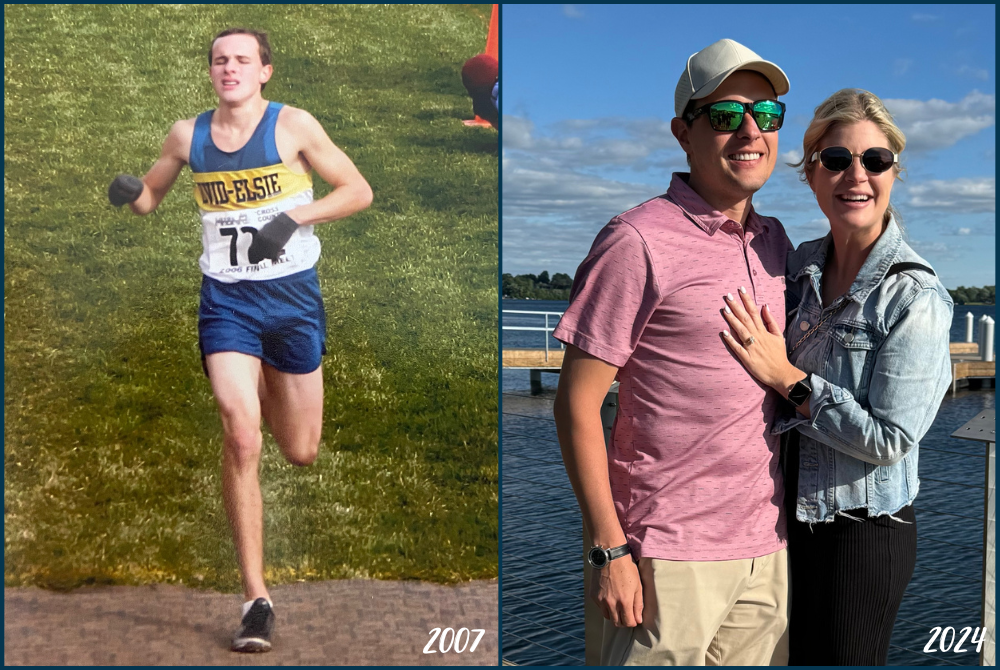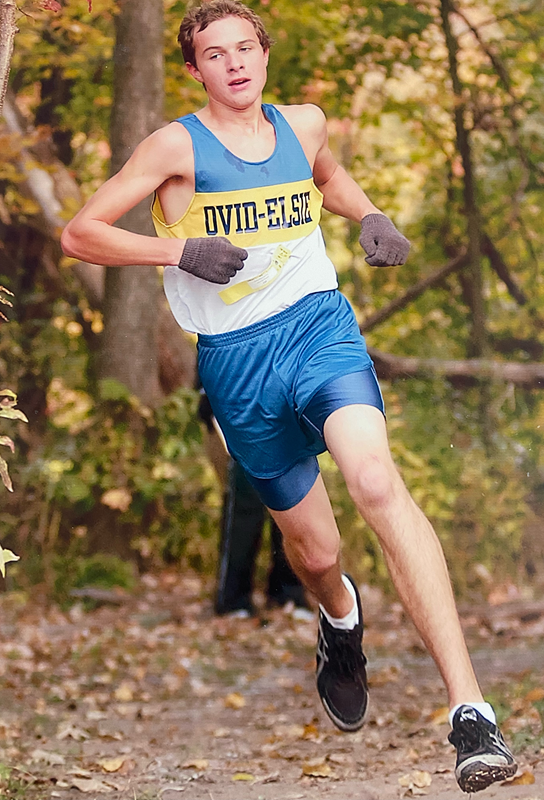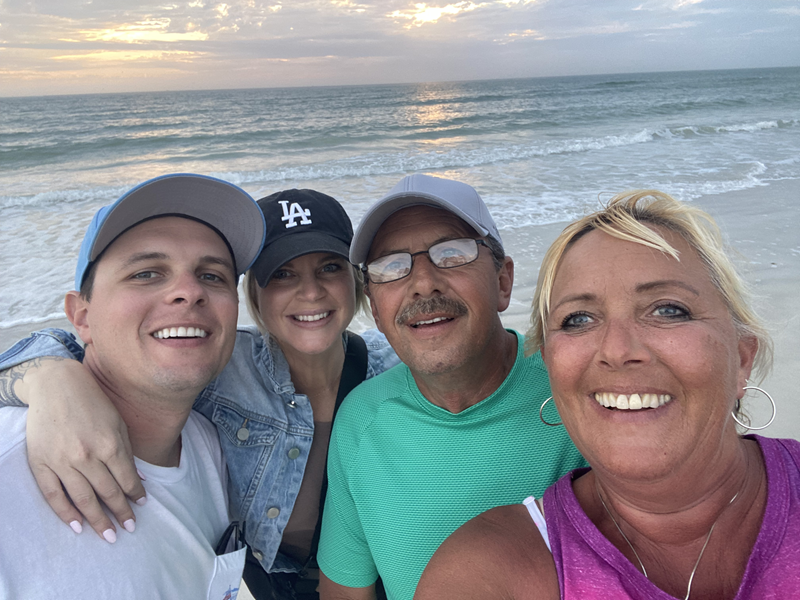
Ovid-Elsie Running Legend Darling Seeking to 'Win the Day' on Trading Floor
By
Paul Costanzo
Special for MHSAA.com
August 13, 2024
Maverick Darling’s competitive running days have been behind him for nearly a decade, but the eight-time MHSAA Finals champion from Ovid-Elsie isn’t done competing.
 Darling, who was also a five-time All-American at Wisconsin, is now fighting for wins on the Viking Forest Products lumber trading floor in Minnesota.
Darling, who was also a five-time All-American at Wisconsin, is now fighting for wins on the Viking Forest Products lumber trading floor in Minnesota.
“Our trading floor is very unique,” Darling said. “We have 60 traders, and probably 30-35 of them are former student-athletes in college. It’s very competitive, but kind of like a locker room. It’s kind of a unique way for me to still be competitive even though I’m not in athletics. I really love it.”
Darling is a commodity trader at Viking Forest, trading mostly OSB, plywood and dimensional lumber to buyers throughout the United States. He lives with his fiancé Danielle and their two dogs in Plymouth, Minn., a suburb of Minneapolis.
Lessons learned while working toward Finals titles on the dirt roads of Ovid and national goals on the trails of Madison, Wis., are helping him find success again.
“My lessons I learned from running and the reward, whether good, great or OK, is that no matter the day, you have to go put in the effort and work, and it carries over to my work,” he said. “I now literally start over every day. We had a saying: ‘Win the day.’ And ‘Win the day’ kind of means something different for every day. I try to apply that to my life. It’s motivating to be successful every day.”
Friendly competition between teammates leading to greater success also carried over from cross country and track to the trading floor.
“We have a department where it feels almost like my cross country team in college,” he said. “One guy will put up 30 orders that day, and we’re all happy for that person. The synergy between the group is awesome. But it motivates me to be like, tomorrow that’s going to be me.”
Darling had spent his first three years out of Wisconsin running professionally and had coaching stops at Iona and Cal-Berkeley after that. But when the pandemic hit, he stepped away from coaching and made the move to trading.
 That ended a spectacular career in the sport, which was actually second choice for most of Darling’s childhood.
That ended a spectacular career in the sport, which was actually second choice for most of Darling’s childhood.
Growing up, he was a top snowmobile racer, along with his brother.
“My first (high school) cross country race, I took seventh,” Darling said. “I didn’t know better, but that’s pretty good. My mom was like, ‘Seventh? You know, we’re used to first or second (in snowcross).’ We’re not a running family. I started at about 18 minutes in the 5K, and at the state meet I finished eighth and ran 16:13. I was like, ‘OK, maybe this is something I can really be good at.’”
It was at the end of his junior year, after winning his heat at the Nike Outdoor Nationals, that Darling turned his entire focus to running. By that time, he had already won two Division 3 cross country titles, two 3,200-meter titles and one 1,600 at MHSAA Finals.
He was training often, but knew he was undertrained because of the limitations on where and when he could run during mid-Michigan winters. Colleges knew it, too, and that led to a barrage of communication as soon as they were able to reach out.
“I probably had 150 of those (hand-written letters) sent to the house,” Darling said. “I would get two to three phone calls a night after July 1. It wasn’t like overwhelming, because I was pretty confident at that point where I wanted to go to school.”
Darling committed to Wisconsin on the day of the Lower Peninsula Cross Country Finals his senior year. He also won his third Finals title that day with a then-Division 3 record time of 14:52. At the time, it was the third fastest time ever run in Michigan.
He would later win his second straight 1,600/3,200 double at the Track & Field Finals, running 8:58 in the 3,200 during the season, which was the 12th-best high school time in the country that year.
The choice to go to Wisconsin was based on his drive to be challenged as much as possible.
“I thought, ‘If I come into this room, I’m probably the eighth or ninth best runner in this room – maybe,’” Darling said. “I had such a great recruiting trip. I grew up in Ovid, and everything I ran there was pretty much dirt roads. Wisconsin has a lot of dirt trails, and I kind of loved that. I could run from our locker room and be on a trail in a mile, mile and a half.”
 Darling’s collegiate career proved he had made the right decision. He was the Big Ten Freshman of the Year for the 2009 cross country season, and an All-American in 2010 and 2012. He was a three-time All-American in track, as well.
Darling’s collegiate career proved he had made the right decision. He was the Big Ten Freshman of the Year for the 2009 cross country season, and an All-American in 2010 and 2012. He was a three-time All-American in track, as well.
The Badgers also had massive team success during Darling’s tenure, winning a cross country national title in 2011, four Big Ten cross country titles and two Big Ten track & field titles.
Darling was surrounded by great runners throughout his time in Madison, including close friend Mohammed Ahmed, who finished fourth in the 10,000 meters at this Olympics, one spot behind another Michigan distance star, Grand Blanc’s Grant Fisher.
Watching the results of a distance boom he was a big part of has been a joy for Darling this summer.
“I thought I was pretty good, then watching these guys – it’s jealousy,” he said with a laugh. “And also, it’s just cool to see. Michigan is one of the best distance states men’s and women’s-wise. It’s great to see them not only be on the international level, but to have that success.”
2024 Made In Michigan
August 8: Shores Star Walker Continues Drive for Hoops Greatness as College Coach - Read
August 6: MCC's Glover Fills Key Role as Athletic Trainer for Super Bowl Champions - Read
August 1: Lessons from Multi-Sport Experience Guide Person in Leading New Team - Read
July 30: After Successful 'Sequel,' Suttons Bay's Hursey Embarking on Next Chapter - Read
July 24: East Kentwood Run Part of Memorable Start on Knuble's Way to NHL, Olympics - Read
July 22: Monroe High Memories Remain Rich for Michigan's 1987 Mr. Baseball - Read
July 17: Record-Setting Viney Gained Lifelong Confidence at Marine City - Read
July 11: High School 'Hoop Squad' Close to Heart as Hughes Continues Coaching Climb - Read
July 10: Nightingale Embarking on 1st Season as College Football Head Coach - Read
June 28: E-TC's Witt Bulldozing Path from Small Town to Football's Biggest Stage - Read
PHOTOS (Top) At left, Maverick Darling crosses the finish line during a race as an Ovid-Elsie senior in 2007; at right Darling poses with fiancé Danielle. (Middle) Darling rounds a turn during a high school race. (Below) Darling and Danielle enjoy a sunset over the water with her parents. (Photos courtesy of Maverick Darling.)

Track Gaining Speed Toward Future with Electronic Starting Devices
By
Steve Vedder
Special for MHSAA.com
May 23, 2023
Aubrey Greenfield thinks it might be the perfect time to reevaluate 130 years of tradition.
For a number of reasons, from technical to personal, the Oxford senior sprinter believes it makes sense for the crack of a starting pistol to be eliminated from high school track meets.
Because track meets would benefit in various ways from lowering costs to easier setup at meets to the human factor of competitors not having to flinch at the crack of a pistol shot, Greenfield believes the sport has a chance to embrace new technology – electronic starting devices (ESD).
In essence, an ESD replaces the starting pistol with a light flash, tone sound or both to begin a race.
"High school sports should put the athlete first," Greenfield said. "We should promote sports, and eliminating starting pistols promotes health in terms of PTSD or trauma for athletes and spectators and that would be good. I would like to think people would say that's a good idea."
In fact, Greenfield would go as far as to say if there was not an implementation of electronic starting devices, many of her teammates would have considered giving up the sport.
"If it's something that helps us compete safely, we're all for it," she said.
Greenfield's opinion apparently is spreading. Michigan High School Athletic Association senior assistant director Cody Inglis said the use of ESD makes it both affordable for meet starters and sensible for athletes and fans to rethink the use of starting pistols. While the MHSAA is not mandating electronic starting devices, it does promote the use of what Inglis calls "emerging technology." He notes that ESD are becoming the norm for organizations such as USA Track & Field, the NCAA and an increasing number of high schools.
 "I think we have to embrace new technology, and we think this will be something that takes hold," Inglis said.
"I think we have to embrace new technology, and we think this will be something that takes hold," Inglis said.
A key part of embracing ESD is the human element. The tragic Oxford High School shooting Nov. 30, 2021, that took the lives of four students while injuring seven others should not be relived even for a fleeting instance at a high school sporting event. Oxford athletic director Tony DeMare said the school began using ESD at every meet, including the MHSAA Lower Peninsula Division 1 Finals last June. He said that decision was embraced by virtually all schools Oxford encountered.
"We were very convinced that the alternative (of ESD) would promote a healthy attitude," DeMare said. "We were overwhelmed with the positive response. If a school was on the fence about it or might not be for it, I think we've started to see the tide turn in favor of people willing to listen and learn about electronic starting devices."
Inglis said the MHSAA is acutely aware of what the crack of a starting pistol can mean to athletes and fans.
"It's unimaginable what Oxford went through, and this is a small way we can help," he said. "We look at a (starting pistol) and think, ‘Could we do something else?’ It's a way of helping to solve a problem."
Over the last several years, the MHSAA has embraced finding an alternative to starting pistols. Inglis noted the discussion started with the cost and diminishing availability of 32-caliber ammunition that meet starters use. A box of ammunition, if it can be found, is around $75 a box.
In addition to cost, there is potential damage from excessive exposure to 150-plus decibels of sound generated by the traditional 32-caliber blanks. Medical studies show damage to ears caused by decibel levels above 120 dB.
The tragedy at Oxford accelerated the conversation.
Inglis said the cost of ESD can be likened to a school sinking money into artificial surfaces at football fields. Yes, there is a great cost at first, but over time money is ultimately saved. An ESD system itself ranges between $200 and $500. Speakers also may need to be purchased, but with ESD starting events like the 800 and 1,600-meter relays positioned near the outside lanes 8, 7, 6 and 5 would result in improved hearing by athletes at the start of a race.
There is one challenge with ESD that track administrators are working to overcome – lighting conditions that lessen the ability to see the ESD’s LED light or strobe when the button is pressed by a starter to begin a race. But that vision difficulty resulting from clear blue skies and backgrounds of setting suns can be substantially improved by incorporating a black background with an ESD – something as simple as a starter holding up black cardboard behind the lighting mechanism at the start of an event.
Inglis said when all factors are considered, the use of ESD makes sense.
 "With the climate we live in nowadays, no lookalike guns is good," he said. "We're not mandating this. But people are saying this is affordable."
"With the climate we live in nowadays, no lookalike guns is good," he said. "We're not mandating this. But people are saying this is affordable."
While switching to ESD would break 130 years of tradition, the timing could be a step forward, said Jeff Hollobaugh, co-author of the book "The Fleet Feet of Spring: Michigan's High School State Championships in Track & Field." He said while no definitive answer is possible, it's likely starting pistols were used at the inaugural state meet at the Jackson Fairgounds in 1895. The meet, which included events like tossing a 16-pound shot put, bike races and a 100-meter sprint, was sponsored by the Michigan Interscholastic Athletic Association (a predecessor to the MHSAA) and comprised mostly of the state's larger schools.
Hollobaugh's sentiments echo what many involved in today's high school track & field believe in terms of making a transition from starting pistols to electronic starting devices.
"It's a change, not necessarily good or bad, just different," he said. "It's not a drastic change, but it will take some getting used to. But it is the future. In the end, we'll all be fine."
DeMare believes the future of high school track will definitely include ESD.
"Our desire is that the practicality and sensibility of this will overcome the alternative," he said. "I think we'll see the automation and electronics taking hold of certain elements in track, and people will embrace it."
PHOTOS (Top) Runners watch official Bertha Smiley as they prepare to begin a race during last season's Lower Peninsula Division 1 Finals at Rockford. (Middle) An electronic starting device provided by VS Athletics was used to start those races. (Below) Smiley sets to begin an event. (Photos provided by David Kuderka/VS Athletics.)

